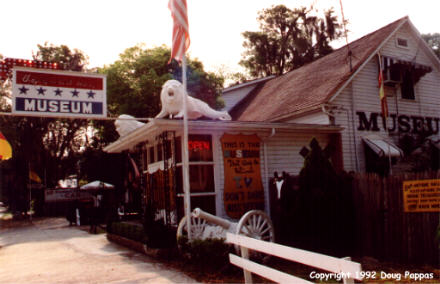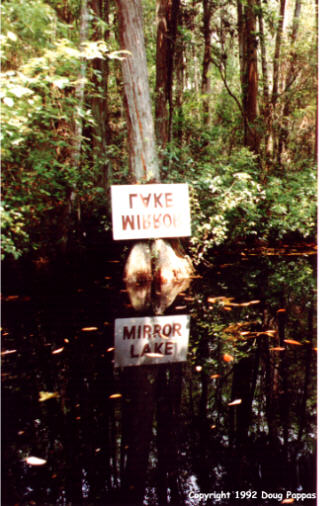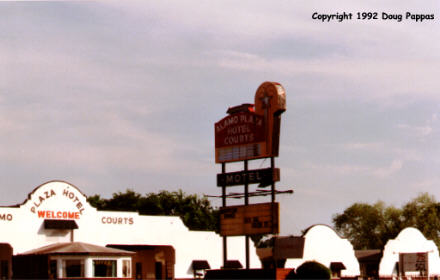Saturday, April 25, 1992...
Drove back down to St. Augustine to begin the day. I photographed the Best Western Historic Inn advertising itself as the newest motel in town, and then swung back to the Tragedy in U.S. History Museum. Anyone who's never been there, should strike a blow for exploitative, bad-taste tourism by turning from Route 1 Business through the gates advertising the Fountain of Youth, then stopping at the second house on the right. The Chamber of Commerce doesn't want to admit it exists; the tour buses don't stop; it's up to us!

The Tragedy in U.S. History Museum occupies part of the owner's residence. Approaching the entrance, prospective visitors are greeted by an effigy of Lee Harvey Oswald sighting his gun through a picture window. In fact, the Museum was inspired by John F. Kennedy's assassination: Kennedy's body was barely cold when founder Buddy Hough journeyed to Dallas in search of assassination memorabilia. He returned with Oswald's bedroom furniture; the car in which he transported his gun to the Texas School Book Depository; and the ambulance which took Oswald to the hospital after he was shot by Jack Ruby. The walls are lined with clippings of the Kennedy assassination, as well as a frame-by-frame blowup of the Zapruder film.
But this is not just a one-death attraction. In the back yard sits a convertible claimed to be the car in which actress Jayne Mansfield was decapitated, along with the vehicle in which Warren Beatty and Faye Dunaway were "gunned down" for the movie Bonnie and Clyde. A human skeleton is displayed near a collection of antique torture devices. An even more entertaining set of clippings chronicles the owner's battles with local authorities. The night before the museum was set to open, the city commission held an emergency meeting to revoke its operating permit, and the Tragedy in U.S. History Museum still doesn't appear on St. Augustine's "official" list of attractions.
[Alas, the Tragedy in U.S. History Museum closed several years after my visit.]
Heading north toward Jacksonville, I was reminded yet again of the power of traffic engineers. David Johnson's souvenir and fruit stand/cafeteria blanketed Route 1 with a dozen billboards in each direction, just as roadside businesses had done for decades, but when I passed it was hard to tell the store was even open. There was only one customer, and a big For Sale sign filled. It was only a half mile south of the access road leading to the Interstate, but that was enough to kill the business.
Downtown Jacksonville offered nothing, but soon enough I was headed north into rural Georgia, away from the traffic. Deep in the Georgia underbrush, a billboard dating to the Forties signaled travelers to follow Route 1 north as the best route to Augusta, Raleigh and New York, but in the five minutes I spent stopped to photograph it, only one car made the turn.

Fifteen miles later, I turned into the Okefenokee Swamp Park south of Waycross. At least four hundred Georgia schoolkids, all ages from grammar school through high school, were touring the place; fortunately I was able to avoid them. The park has a half-dozen small exhibits highlighting indigenous animal and plant life, as well as a quarter-mile walk to an observation tower and a dock offering half-hour, two-mile and two-hour, ten-mile tours. I took the shorter tour, narrated by a local guide with an almost comically thick drawl The drawls wasn't the thickest parts of the tour, either: at Mirror Lake, the water's so thick with decaying vegetation as to be absolutely opaque. Wandered around the grounds awhile, then returned to the road.

After the swamp, the drive across Georgia and South Carolina offered little excitement. Most of it consisted of two-lane roads passing through towns small enough that even the 7-11s stayed away. Stopped for the night in Columbia, South Carolina.
Go to the next day
Back to Old Road Trips menu
Back to ROADSIDEPHOTOS.COM home page